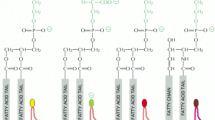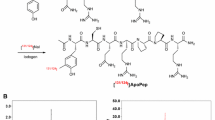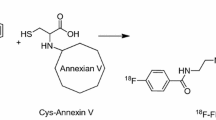Abstract
Cell death is involved in numerous pathological conditions such as cardiovascular disorders, ischemic stroke and organ transplant rejection, and plays a critical role in the treatment of cancer. Cell death imaging can serve as a noninvasive means to detect the severity of tissue damage, monitor the progression of diseases, and evaluate the effectiveness of treatments, which help to provide prognostic information and guide the formulation of individualized treatment plans. The high abundance of phosphatidylethanolamine (PE), which is predominantly confined to the inner leaflet of the lipid bilayer membrane in healthy mammalian cells, becomes exposed on the cell surface in the early stages of apoptosis or accessible to the extracellular milieu when the cell suffers from necrosis, thus representing an attractive target for cell death imaging. Duramycin is a tetracyclic polypeptide that contains 19 amino acids and can bind to PE with excellent affinity and specificity. Additionally, this peptide has several favorable structural traits including relatively low molecular weight, stability to enzymatic hydrolysis, and ease of conjugation and labeling. All these highlight the potential of duramycin as a candidate ligand for developing PE-specific molecular probes. By far, a couple of duramycin-based molecular probes such as Tc-99 m-, F-18-, or Ga-68-labeled duramycin have been developed to target exposed PE for in vivo noninvasive imaging of cell death in different animal models. In this review article, we describe the state of the art with respect to in vivo imaging of cell death using duramycin-based molecular probes, as validated by immunohistopathology.


Copyright © 2018 by the American College of Cardiology Foundation. Published by Elsevier)

Copyright © 2018 by the American College of Cardiology Foundation. Published by Elsevier)

Copyright © 2017 by the Society of Nuclear Medicine and Molecular Imaging)

Copyright © 2019 The Author(s). This is an open access article under the CC BY-NC-ND license)

Copyright © 2017 by the Shock Society)

Copyright © 2018 by the Society of Nuclear Medicine and Molecular Imaging)

Copyright © 2019 World Molecular Imaging Society)
Similar content being viewed by others
Change history
22 February 2022
A Correction to this paper has been published: https://doi.org/10.1007/s11307-022-01711-7
References
Rabinovich-Nikitin I, Lieberman B, Martino TA, Kirshenbaum LA (2019) Circadian-regulated cell death in cardiovascular diseases. Circulation 139:965–980
Radak D, Katsiki N, Resanovic I et al (2017) Apoptosis and acute brain ischemia in ischemic stroke. Curr Vasc Pharmacol 15:115–122
Hotchkiss RS, Tinsley KW, Karl IE (2003) Role of apoptotic cell death in sepsis. Scand J Infect Dis 35(9):585–592
Gottlieb RA (2011) Cell death pathways in acute ischemia/reperfusion injury. J Cardiovasc Pharmacol Ther 16:233–238
Cippà PE, Fehr T (2017) Pharmacological modulation of cell death in organ transplantation. Transpl Int 30:851–859
Rello-Varona S, Herrero-Martin D, Lopez-Alemany R, Munoz-Pinedo C, Tirado OM (2015) “(Not) all (dead) things share the same breath”: identification of cell death mechanisms in anticancer therapy. Cancer Res 75:913–917
Carneiro BA, El-Deiry WS (2020) Targeting apoptosis in cancer therapy. Nat Rev Clin Oncol 17:395–417
Neves AA, Brindle KM (2014) Imaging cell death. J Nucl Med 55:1–4
Shekhar A, Heeger P, Reutelingsperger C et al (2018) Targeted imaging for cell death in cardiovascular disorders. JACC Cardiovasc Imaging 11:476–493
Rybczynska AA, Boersma HH, de Jong S et al (2018) Avenues to molecular imaging of dying cells: focus on cancer. Med Res Rev 38:1713–1768
Zhang D, Jin Q, Jiang C et al (2020) Imaging cell death: focus on early evaluation of tumor response to therapy. Bioconjug Chem 31:1025–1051
van Meer G, Voelker DR, Feigenson GW (2008) Membrane lipids: where they are and how they behave. Nat Rev Mol Cell Biol 9:112–124
Vance JE (2008) Phosphatidylserine and phosphatidylethanolamine in mammalian cells: two metabolically related aminophospholipids. J Lipid Res 49:1377–1387
Fadeel B, Xue D (2009) The ins and outs of phospholipid asymmetry in the plasma membrane: roles in health and disease. Crit Rev Biochem Mol Biol 44:264–277
Emoto K, Toyama-Sorimachi N, Karasuyama H, Inoue K, Umeda M (1997) Exposure of phosphatidylethanolamine on the surface of apoptotic cells. Exp Cell Res 232:430–434
Barnett Foster D, Abul-Milh M, Huesca M, Lingwood CA (2000) Enterohemorrhagic Escherichia coli induces apoptosis which augments bacterial binding and phosphatidylethanolamine exposure on the plasma membrane outer leaflet. Infect Immun 68:3108–3115
Marconescu A, Thorpe PE (2008) Coincident exposure of phosphatidylethanolamine and anionic phospholipids on the surface of irradiated cells. Biochim Biophys Acta 1778:2217–2224
Yates KR, Welsh J, Udegbunam NO et al (2012) Duramycin exhibits antiproliferative properties and induces apoptosis in tumour cells. Blood Coagul Fibrinolysis 23:396–401
Belhocine TZ, Prato FS (2011) Transbilayer phospholipids molecular imaging EJNMMI Res 1:17
Zhao M (2011) Lantibiotics as probes for phosphatidylethanolamine. Amino Acids 41:1071–1079
Elvas F, Stroobants S, Wyffels L (2017) Phosphatidylethanolamine targeting for cell death imaging in early treatment response evaluation and disease diagnosis. Apoptosis 22:971–987
Smith BA, Smith BD (2012) Biomarkers and molecular probes for cell death imaging and targeted therapeutics. Bioconjug Chem 23:1989–2006
Hayashi F, Nagashima K, Terui Y et al (1990) The structure of PA48009: the revised structure of duramycin. J Antibiot (Tokyo) 43:1421–1430
Fredenhagen A, Fendrich G, Märki F et al (1990) Duramycins B and C, two new lanthionine containing antibiotics as inhibitors of phospholipase A2. Structural revision of duramycin and cinnamycin. J Antibiot (Tokyo) 43:1403–1412
Machaidze G, Ziegler A, Seelig J (2002) Specific binding of Ro 09–0198 (cinnamycin) to phosphatidylethanolamine: a thermodynamic analysis. Biochemistry 41:1965–1971
Machaidze G, Seelig J (2003) Specific binding of cinnamycin (Ro 09–0198) to phosphatidylethanolamine. Comparison between micellar and membrane environments. Biochemistry 42:12570–12576
Iwamoto K, Hayakawa T, Murate M et al (2007) Curvature-dependent recognition of ethanolamine phospholipids by duramycin and cinnamycin. Biophys J 93:1608–1619
Huo L, Ökesli A, Zhao M, van der Donk WA (2017) Insights into the biosynthesis of duramycin. Appl Environ Microbiol 83:e02698-e2716
Mosayebnia M, Hajiramezanali M, Shahhosseini S (2020) Radiolabeled peptides for molecular imaging of apoptosis. Curr Med Chem 27:7064–7089
Hosseinimehr SJ (2020) Radiolabeled peptides in imaging and therapy: basic and clinical perspectives. Curr Med Chem 27:6966–6967
An L, Cogan DP, Navo CD et al (2018) Substrate-assisted enzymatic formation of lysinoalanine in duramycin. Nat Chem Biol 14:928–933
Ong YS, Gao L, Kalesh KA et al (2017) Recent advances in synthesis and identification of cyclic peptides for bioapplications. Curr Top Med Chem 17:2302–2318
Li Z, Wells CW, Esmon CT, Zhao M (2009) Phosphatidylethanolamine at the endothelial surface of aortic flow dividers. J Thromb Haemost 7:227–229
Zhixin L, Wells CW, North PE et al (2011) Phosphatidylethanolamine at the luminal endothelial surface-implications for hemostasis and thrombotic autoimmunity. Clin Appl Thromb Hemost 17:158–163
Stafford JH, Thorpe PE (2011) Increased exposure of phosphatidylethanolamine on the surface of tumor vascular endothelium. Neoplasia 13:299–308
Larson MC, Woodliff JE, Hillery CA, Kearl TJ, Zhao M (2012) Phosphatidylethanolamine is externalized at the surface of microparticles. Biochim Biophys Acta 1821:1501–1507
Hou S, Johnson SE, Zhao M (2015) A one-step staining probe for phosphatidylethanolamine. ChemBioChem 16:1955–1960
Broughton LJ, Giuntini F, Savoie H et al (2016) Duramycin-porphyrin conjugates for targeting of tumour cells using photodynamic therapy. J Photochem Photobiol B 163:374–384
Hullin-Matsuda F, Makino A, Murate M, Kobayashi T (2016) Probing phosphoethanolamine-containing lipids in membranes with duramycin/cinnamycin and aegerolysin proteins. Biochimie 130:81–90
Sun T, Wei L, Tian H et al (2021) Novel PET/CT tracers for targeted imaging of membrane receptors to evaluate cardiomyocyte apoptosis and tissue repair process in a rat model of myocardial infarction. Apoptosis 26:460–473
Zhao M, Li Z, Bugenhagen S (2008) 99mTc-labeled duramycin as a novel phosphatidylethanolamine-binding molecular probe. J Nucl Med 49:1345–1352
Zhao M, Li Z (2012) A single-step kit formulation for the 99mTc-labeling of HYNIC-duramycin. Nucl Med Biol 39:1006–1011
Audi S, Li Z, Capacete J et al (2012) Understanding the in vivo uptake kinetics of a phosphatidylethanolamine-binding agent 99mTc-duramycin. Nucl Med Biol 39:821–825
Zhang Y, Stevenson GD, Barber C et al (2013) Imaging of rat cerebral ischemia-reperfusion injury using 99mTc-labeled duramycin. Nucl Med Biol 40:80–88
Wang L, Wang F, Fang W et al (2015) The feasibility of imaging myocardial ischemic/reperfusion injury using 99mTc-labeled duramycin in a porcine model. Nucl Med Biol 42:198–204
Kawai H, Chaudhry F, Shekhar A et al (2018) Molecular imaging of apoptosis in ischemia reperfusion injury with radiolabeled duramycin targeting phosphatidylethanolamine: effective target uptake and reduced nontarget organ radiation burden. JACC Cardiovasc Imaging 11:1823–1833
Wu JC, Qin X, Neofytou E (2018) Radiolabeled duramycin: promising translational imaging of myocardial apoptosis. JACC Cardiovasc Imaging 11:1834–1836
Liu Z, Barber C, Gupta A et al (2019) Imaging assessment of cardioprotection mediated by a dodecafluoropentane oxygen-carrier administered during myocardial infarction. Nucl Med Biol 70:67–77
Tan H, Abudupataer M, Qiu L et al (2021) 99mTc-labeled duramycin for detecting and monitoring cardiomyocyte death and assessing atorvastatin cardioprotection in acute myocardial infarction. Chem Biol Drug Des 97:210–220
Liu Z, Larsen BT, Lerman LO et al (2016) Detection of atherosclerotic plaques in ApoE-deficient mice using 99mTc-duramycin. Nucl Med Biol 43:496–505
Hu Y, Liu G, Zhang H et al (2018) A comparison of [99mTc]duramycin and [99mTc]annexin V in SPECT/CT imaging atherosclerotic plaques. Mol Imaging Biol 20:249–259
Chaudhry F, Kawai H, Johnson KW et al (2020) Molecular imaging of apoptosis in atherosclerosis by targeting cell membrane phospholipid asymmetry. J Am Coll Cardiol 76:1862–1874
Tawakol A, Abohashem S, Zureigat H (2020) Imaging apoptosis in atherosclerosis: from cell death, a ray of light. J Am Coll Cardiol 76:1875–1877
Nakahara T, Petrov A, Tanimoto T et al (2018) Molecular imaging of apoptosis in cancer therapy-related cardiac dysfunction before LVEF reduction. JACC Cardiovasc Imaging 11:1203–1205
Chaudhry F, Adapoe M, Johnson KW et al (2020) Molecular imaging of cardiac allograft rejection: targeting apoptosis with radiolabeled duramycin. JACC Cardiovasc Imaging 13:1438–1441
Hu C, Tan H, Lin Q et al (2019) SPECT/CT imaging of apoptosis in aortic aneurysm with radiolabeled duramycin. Apoptosis 24:745–755
Li DY, Busch A, Jin H et al (2018) H19 induces abdominal aortic aneurysm development and progression. Circulation 138:1551–1568
Wuest M, Perreault A, Richter S, Knight JC, Wuest F (2019) Targeting phosphatidylserine for radionuclide-based molecular imaging of apoptosis. Apoptosis 24:221–244
Wang X, Feng H, Zhao S et al (2017) SPECT and PET radiopharmaceuticals for molecular imaging of apoptosis: from bench to clinic. Oncotarget 8:20476–20495
Elvas F, Vangestel C, Rapic S et al (2015) Characterization of duramycin as a SPECT imaging agent for early assessment of tumor apoptosis. Mol Imaging Biol 17:838–847
Elvas F, Vangestel C, Pak K et al (2016) Early prediction of tumor response to treatment: preclinical validation of 99mTc-duramycin. J Nucl Med 57:805–811
Elvas F, Boddaert J, Vangestel C et al (2017) 99mTc-Duramycin SPECT imaging of early tumor response to targeted therapy: a comparison with 18F-FDG PET. J Nucl Med 58:665–670
Palmieri L, Elvas F, Vangestel C et al (2018) [99mTc]duramycin for cell death imaging: impact of kit formulation, purification and species difference. Nucl Med Biol 56:1–9
Luo R, Niu L, Qiu F et al (2016) Monitoring apoptosis of breast cancer xenograft after paclitaxel treatment with 99mTc-labeled duramycin SPECT/CT. Mol Imaging 15:1536012115624918
Li Y, Liu C, Xu X et al (2018) [99mTc]Tc-duramycin, a potential molecular probe for early prediction of tumor response after chemotherapy. Nucl Med Biol 66:18–25
Zhou J, Hu P, Si Z et al (2019) Treatment of hepatocellular carcinoma by intratumoral injection of 125I-AA98 mAb and its efficacy assessments by molecular imaging. Front Bioeng Biotechnol 7:319
Liu C, Li Y, Qin X et al (2020) Early prediction of tumor response after radiotherapy in combination with cetuximab in nasopharyngeal carcinoma using 99mTc-duramycin imaging. Biomed Pharmacother 125:109947
Russell SJ, Peng KW, Bell JC (2012) Oncolytic virotherapy. Nat Biotechnol 30:658–670
Lawler SE, Speranza MC, Cho CF, Chiocca EA (2017) Oncolytic viruses in cancer treatment: a review. JAMA Oncol 3:841–849
Seymour LW, Fisher KD (2016) Oncolytic viruses: finally delivering. Br J Cancer 114:357–361
Zhang L, Suksanpaisan L, Jiang H et al (2019) Dual-isotope SPECT imaging with NIS reporter gene and duramycin to visualize tumor susceptibility to oncolytic virus infection. Mol Ther Oncolytics 15:178–185
Neirinckx RD, Burke JF, Harrison RC et al (1988) The retention mechanism of technetium-99m-HM-PAO: intracellular reaction with glutathione. J Cereb Blood Flow Metab 8:S4–S12
Clough AV, Audi SH, Haworth ST, Roerig DL (2012) Differential lung uptake of 99mTc-hexamethylpropyleneamine oxime and 99mTc-duramycin in the chronic hyperoxia rat model. J Nucl Med 53:1984–1991
Brueckl C, Kaestle S, Kerem A et al (2006) Hyperoxia-induced reactive oxygen species formation in pulmonary capillary endothelial cells in situ. Am J Respir Cell Mol Biol 34:453–463
Merker MP, Audi SH, Lindemer BJ, Krenz GS, Bongard RD (2007) Role of mitochondrial electron transport complex I in coenzyme Q1 reduction by intact pulmonary arterial endothelial cells and the effect of hyperoxia. Am J Physiol Lung Cell Mol Physiol 293:L809-819
Audi SH, Jacobs ER, Zhao M et al (2015) In vivo detection of hyperoxia-induced pulmonary endothelial cell death using 99mTc-duramycin. Nucl Med Biol 42:46–52
Diao M, Zhang S, Wu L et al (2016) Hydrogen gas inhalation attenuates seawater instillation-induced acute lung injury via the Nrf2 pathway in rabbits. Inflammation 39:2029–2039
Kohama K, Yamashita H, Aoyama-Ishikawa M et al (2015) Hydrogen inhalation protects against acute lung injury induced by hemorrhagic shock and resuscitation. Surgery 158:399–407
Kawamura T, Wakabayashi N, Shigemura N et al (2013) Hydrogen gas reduces hyperoxic lung injury via the Nrf2 pathway in vivo. Am J Physiol Lung Cell Mol Physiol 304:L646-656
Audi SH, Jacobs ER, Zhang X et al (2017) Protection by inhaled hydrogen therapy in a rat model of acute lung injury can be tracked in vivo using molecular imaging. Shock 48:467–476
Thind K, Chen A, Friesen-Waldner L et al (2013) Detection of radiation-induced lung injury using hyperpolarized 13C magnetic resonance spectroscopy and imaging. Magn Reson Med 70:601–609
Gao F, Fish BL, Moulder JE, Jacobs ER, Medhora M (2013) Enalapril mitigates radiation-induced pneumonitis and pulmonary fibrosis if started 35 days after whole-thorax irradiation. Radiat Res 180:546–552
Medhora M, Haworth S, Liu Y et al (2016) Biomarkers for radiation pneumonitis using noninvasive molecular imaging. J Nucl Med 57:1296–1301
Johnson SE, Li Z, Liu Y, Moulder JE, Zhao M (2013) Whole-body imaging of high-dose ionizing irradiation-induced tissue injuries using 99mTc-duramycin. J Nucl Med 54:1397–1403
Balk RA (2014) Systemic inflammatory response syndrome (SIRS): where did it come from and is it still relevant today? Virulence 5:20–26
Delvaeye T, Wyffels L, Deleye S et al (2018) Noninvasive whole-body imaging of phosphatidylethanolamine as a cell death marker using 99mTc-duramycin during TNF-induced SIRS. J Nucl Med 59:1140–1145
Johnson SE, Ugolkov A, Haney CR et al (2019) Whole-body imaging of cell death provides a systemic, minimally invasive, dynamic, and near-real time indicator for chemotherapeutic drug toxicity. Clin Cancer Res 25:1331–1342
Yao S, Hu K, Tang G et al (2014) Positron emission tomography imaging of cell death with [18F]FPDuramycin. Apoptosis 19:841–850
Haskali MB, Denoyer D, Roselt PD, Hicks RJ, Hutton CA (2019) Radiosynthesis and preliminary in vivo evaluation of 18F-labelled glycosylated duramycin peptides for imaging of phosphatidylethanolamine during apoptosis. Med Chem Commun 10:1930–1934
Beer AJ, Haubner R, Goebel M et al (2005) Biodistribution and pharmacokinetics of the αvβ3-selective tracer 18F-galacto-RGD in cancer patients. J Nucl Med 46:1333–1341
Maschauer S, Haubner R, Kuwert T, Prante O (2014) 18F-glyco-RGD peptides for PET imaging of integrin expression: efficient radiosynthesis by click chemistry and modulation of biodistribution by glycosylation. Mol Pharm 11:505–515
Moradi SV, Hussein WM, Varamini P, Simerska P, Toth I (2016) Glycosylation, an effective synthetic strategy to improve the bioavailability of therapeutic peptides. Chem Sci 7:2492–2500
Li J, Gray BD, Pak KY, Ng CK (2019) Targeting phosphatidylethanolamine and phosphatidylserine for imaging apoptosis in cancer. Nucl Med Biol 78–79:23–30
Yuan G, Liu S, Ma H et al (2020) Targeting phosphatidylethanolamine with fluorine-18 labeled small molecule probe for apoptosis imaging. Mol Imaging Biol 22:914–923
Su S, Xiang X, Lin L et al (2021) Cell death PET/CT imaging of rat hepatic fibrosis with 18F-labeled small molecule tracer. Nucl Med Biol 98–99:76–83
Rix A, Drude NI, Mrugalla A et al (2020) Assessment of chemotherapy-induced organ damage with Ga-68 labeled duramycin. Mol Imaging Biol 22:623–633
Franz S, Muñoz LE, Heyder P, Herrmann M, Schiller M (2015) Unconventional apoptosis of polymorphonuclear neutrophils (PMN): staurosporine delays exposure of phosphatidylserine and prevents phagocytosis by MΦ-2 macrophages of PMN. Clin Exp Immunol 179:75–84
Moreno-Gonzalez G, Vandenabeele P, Krysko DV (2016) Necroptosis: a novel cell death modality and its potential relevance for critical care medicine. Am J Respir Crit Care Med 194:415–428
Krysko O, Aaes TL, Kagan VE et al (2017) Necroptotic cell death in anti-cancer therapy. Immunol Rev 280:207–219
https://researchportal.be/en/project/prediction-tumor-response-treatment-clinical-translation-99mtc-duramycin (accessed on January 7, 2022)
Bazzi MD, Nelsestuen GL (1991) Highly sequential binding of protein kinase C and related proteins to membranes. Biochemistry 30:7970–7977
James ML, Gambhir SS (2012) A molecular imaging primer: modalities, imaging agents, and applications. Physiol Rev 92:897–965
Author information
Authors and Affiliations
Corresponding authors
Ethics declarations
Conflict of Interest
The authors declare that they have no conflict of interest.
Additional information
Publisher's note
Springer Nature remains neutral with regard to jurisdictional claims in published maps and institutional affiliations.
Rights and permissions
About this article
Cite this article
Zhang, D., Gao, M., Jin, Q. et al. Development of Duramycin-Based Molecular Probes for Cell Death Imaging. Mol Imaging Biol 24, 612–629 (2022). https://doi.org/10.1007/s11307-022-01707-3
Received:
Revised:
Accepted:
Published:
Issue Date:
DOI: https://doi.org/10.1007/s11307-022-01707-3




